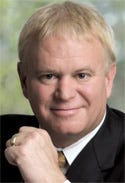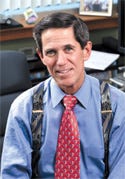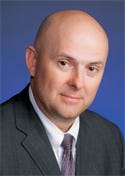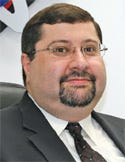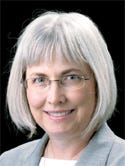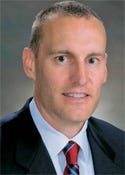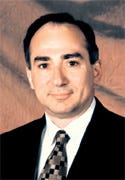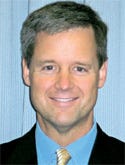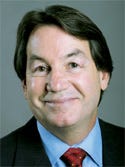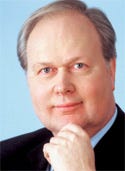This year's featured leaders illustrate medtech's ability to adapt and thrive in an ever-changing business environment.
July 1, 2007
COVER STORY
|
The ability to adapt is a key attribute shared by all successful medical device leaders. In an industry marked by continual change, medtech executives must constantly consider not only how their companies and technologies need to adjust, but also how their own leadership roles and responsibilities must evolve.
In this issue, MX profiles company executives who are both adapting to and driving industry change. This article highlights the executives behind some of industry's most notable acquisitions over the past year, as well as those who have recently moved into challenging new roles. In addition, this year's annual medtech executive profiles include company leaders who are influencing the industry through technology development. Expanded versions of these profiles can be accessed via the MX Web site at www.devicelink.com/mx.
Big Deals
In the medical device industry, as in most industries, no multi-billion-dollar merger goes unnoticed. Often, deals of such size result in a dramatic reshaping of the industry's competitive landscape. In the medtech industry, however, the most significant mergers don't always involve the most significant sums of money. While big money often means big headlines, smaller acquisitions—often focused more on technology than on market share—can also drive substantial industry change. In this section, MX looks at the leaders behind some of the past year's most noteworthy acquisitions.
|
Patrick J. Balthrop |
Patrick J. Balthrop
President and CEO
Luminex Corp.
In March, Luminex Corp. (Austin, TX) completed its acquisition of Tm Bioscience Corp. (Toronto), the company that developed the first multiplexed human disease genotyping test (for cystic fibrosis) to be cleared as an IVD for diagnostic use in the United States.
A Luminex partner for six years, Tm Bioscience is developing a suite of molecular diagnostic tests and proprietary technologies for genetic disorders, pharmacogenetics, and infectious diseases. Luminex's acquisition of Tm Bioscience, estimated at $44 million, represents a significant opportunity for the company to grow in the molecular diagnostics market.
Leading the merger was Luminex president and CEO Patrick J. Balthrop, who joined the company in his current capacity in May 2004. "Every acquisition has its challenges, but we are on or ahead of schedule in integrating Luminex and Tm Bioscience—with no losses of key employees, a renewed organizational vigor and energy, and tremendous excitement for our pipeline of products," Balthrop says. "Our pipeline includes our respiratory viral panel, a molecular assay that simultaneously tests for 19 different viruses and subtypes."
Balthrop says his greatest professional achievement over the past year has been increasing Luminex's research and development investment by more than 50% in 2006. The increase has driven future new product flow while delivering 10 points of gross margin growth.
In addition to the acquisition of Tm Bioscience, Balthrop led several other growth initiatives in 2006. Highlights include further development and adoption of the company's xMAP multiplexing technology, Luminex Bioscience Group's first product launches, and new initiatives in biodefense.
In early 2007, Luminex announced that it had entered into a development and supply agreement with the Fisher Healthcare division of Thermo Fisher Scientific. The agreement provides Fisher with access to Luminex technology in the United States and offers Luminex a broad new customer sales channel for its xMAP-based instruments and assays in molecular diagnostics.
Capping the year, Luminex reported 2006 revenue of $53 million, a 25% increase over the previous year. Royalty revenues—a noteworthy measure of acceptance and adoption of Luminex's technology—were up more than 57% to $8.2 million.
Previously, Balthrop served as president of Fisher Healthcare, where he led a $1 billion integrated business. Prior to Fisher, Balthrop served in a number of leadership positions for more than 20 years with Abbott Laboratories, primarily in Abbott's diagnostics division, including head of worldwide commercial diagnostics operations. His career experience has included research and development, commercial operations, manufacturing, sales and marketing, intellectual property and technology management, and international operations.
|
Richard W. Mott |
Richard W. Mott
President and CEO
Kyphon Inc.
On January 18, 2007, Kyphon Inc. (Sunnyvale, CA) acquired St. Francis Medical Technologies Inc. (Alameda, CA) for $725 million, marking one of the largest medical device acquisitions in the heated spine sector. Undertaken with the leadership of Kyphon president and CEO Richard W. Mott, the acquisition is a key element in Kyphon's business strategy to grow its presence in the minimally invasive spine therapies market.
The acquisition broadens Kyphon's focus in the minimally invasive spine sector. It adds the X-Stop interspinous process decompression technology platform to Kyphon's existing KyphX balloon kyphoplasty technologies for repairing vertebral compression fractures and its recently launched functional anesthetic diskography technology procedure for diagnosing the source of low back pain.
"We have great opportunities in markets that are underpenetrated and genuinely in need of what we have to offer. And we have never been more committed to making the necessary investments to demonstrate the clinical value of our products and reduce the overall economic burden of spinal treatment," Mott says.
Mott has served as Kyphon's president, CEO, and director since September 2002. From January 1998 through March 2002, he held several positions at Wilson Greatbatch Technologies Inc. (Clarence, NY), a developer of components for implantable medical devices. His roles with the company included chief operating officer from December 2000 to March 2002 and senior vice president from January 1998 to November 2000.
|
Jack Cumming |
Jack Cumming
Chairman and CEO
Hologic Inc.
In a move designed to boost its position in women's healthcare, Hologic Inc. (Bedford, MA) intends to purchase Cytyc Corp. (Marlborough, MA) in a cash and stock transaction valued at about $6.2 billion. The new company will operate under the Hologic name, with Cytyc becoming a wholly owned subsidiary. Following the merger—expected to close sometime in the third quarter of this year—Hologic chairman and CEO Jack Cumming will remain CEO in the newly formed company, with Patrick Sullivan, Cytyc's chairman, president, and CEO, assuming the post of chairman.
In announcing the deal this past spring, Cumming described the acquisition as a perfect fit. "By combining our companies' complementary best-in-class products and technologies, we expect to drive enhanced growth and value creation," he said. "Both Hologic and Cytyc have a track record of successfully executing on strategic transactions, and we expect to realize the benefits of this combination quickly and efficiently."
The newly combined company expects to generate $1.7 billion in revenue for fiscal year 2008. It will have more than 3300 employees and direct operations in more than 20 countries. Benefits cited for the merger include the creation of a comprehensive women's health product portfolio with the largest channel coverage in the sector, expanded international presence with product distribution in more than 125 countries, increased cross-selling opportunities generating more than $75 million within the first three years, and estimated annual cost savings of between $25 million and $30 million.
Cumming was appointed Hologic CEO and a director in July 2001 and to the position of chairman of the board in November 2002. He served as president of the company from July 2001 through September 2003. Prior to that, Cumming held the position of corporate senior vice president and president for the company's Lorad systems division, a role he held since joining the company in August 2000.
Prior to joining Hologic, Cumming served as president and managing director of Health Care Markets Group (Houston), a strategic advisory and investment banking firm that he founded in 1984. Prior to forming Health Care Markets Group, he was vice president and division manager for Elscint Inc., a full-line manufacturer of diagnostic imaging equipment.
|
James V. Mazzo |
James V. Mazzo
Chairman, President, and CEO
Advanced Medical Optics Inc.
Although Advanced Medical Optics Inc. (AMO; Santa Ana, CA) controls about 60% of the worldwide surgical instrument market for laser-assisted in situ keratomileusis (LASIK) procedures, the company has not been content to rest on its laurels in recent months.
In January, AMO purchased WaveFront Sciences Inc. (Albuquerque), a leading provider of proprietary wavefront diagnostic systems for refractive surgery and medical research. Then, in April, the company completed its $880 million acquisition of IntraLase Corp. (Irvine, CA), thereby adding the company's femtosecond laser to its arsenal of ophthalmic surgical devices and eye care products. Use of IntraLase's femtosecond laser is increasingly seen as the standard of care in many ophthalmic surgery suites around the world.
The following month, AMO released a statement confirming its interest in exploring the possible acquisition of Bausch & Lomb Inc. (Rochester, NY), which had recently agreed to a $3.67 billion buyout by private equity firm Warburg Pincus. AMO stated that it believed Warburg Pincus's bid undervalued Bausch & Lomb, and that it intended to enter the go-shop process with the intention of exploring a superior offer for the company. Under the deal with Warburg Pincus, Bausch & Lomb can solicit superior proposals from third parties until early July. At press time, AMO had yet to make a bid for the company.
Regardless of whether a bid is made, there's no question that AMO chairman, president, and CEO James V. Mazzo has driven tremendous company growth over the past year. "We've obviously continued to build from a growth standpoint with the successful completion and integration of two major acquisitions, including IntraLase and Wavefront Sciences," Mazzo says. "These acquisitions complement AMO's fundamental growth strategy, particularly in the area of laser vision correction, where we now have the ability to define a new standard of care as the world's leading provider of LASIK technologies.
"Additionally, our research and development portfolio is expanding, and I am pleased that we will be able to build on organic growth from within the company," Mazzo adds. "I'm also very proud of the way we have been able to change the overall strategy of the company by eliminating certain noncore strategic products and repositioning our portfolio to offer industry-leading technologies to our customers and the patients they serve. We did this in a concentrated fashion and executed against it when several people in the industry doubted us."
As AMO has grown, maintaining morale and excitement without becoming too bureaucratic has been a challenge, Mazzo says. "We have integrated various cultures and learned from them, which has helped when bringing employees together to form a global organization," Mazzo says. "By sharing our corporate values, such as accountability and ownership, and by maintaining an entrepreneurial approach through flexibility and adaptation to change, we have been able to remain nimble."
Mazzo has been a member of AMO's board of directors since October 2001. He was president and CEO from the company's inception through May 2006, at which time he also became its chairman of the board. Prior to AMO's spin-off from Allergan Inc. (Irvine, CA) in 2002, Mazzo served in various positions at Allergan, most recently as Allergan's corporate vice president and president for surgical and contact lens care product businesses.
|
Eamonn P. Hobbs |
Eamonn P. Hobbs
President and CEO
AngioDynamics Inc.
In January, AngioDynamics Inc. (Queensbury, NY) acquired RITA Medical Systems Inc. (Fremont, CA) for approximately $220 million. A provider of medical devices for the diagnosis and treatment of peripheral vascular diseases, AngioDynamics looked to the merger as a way to create a diversified medical technology company with a broad line of access, diagnostic, and therapeutic products that enable interventional physicians and surgeons to treat peripheral vascular diseases and cancerous tumors.
Eamonn P. Hobbs, president and CEO of AngioDynamics, says the company's acquisition of RITA brought him a great deal of professional satisfaction. "In RITA, we found an ideal strategic, financial, and cultural fit, which has resulted in the creation of a larger, stronger, and more competitive medical technologies company," Hobbs says. "This new business combination is about growth, leadership, and long-term value creation. AngioDynamics now stands as a leader in serving the needs of interventional radiologists, surgeons, and other medical specialties with a compelling product portfolio of exciting technologies."
Despite the market opportunities opened by AngioDynamics' January acquisition of RITA, the company has also faced its share of challenges this year. "Earlier this year, we were involved in a lawsuit against our VenaCure laser venous treatment, in which a verdict of nonwillful patent infringement went against AngioDynamics," Hobbs says. "We completely disagree with this judgment and are appealing it, but this is a lengthy process. So we faced a major challenge in how to fill the product gap this created in our portfolio. However, with innovation and solid intellectual property as our guiding principles, we were able to rapidly commercialize a product from our R&D pipeline and, in so doing, continue to provide physicians and their patients with technology needed for this important venous disease treatment."
Hobbs, a cofounder of AngioDynamics, has been the company's president and CEO since June 1996. He has more than 25 years' experience in the interventional radiology, interventional cardiology, and gastroenterology medical device industries.
From 1991 until September 2002, Hobbs was a vice president of E-Z-EM (Lake Success, NY), and from October 2002 to May 2004 he was a senior vice president for E-Z-EM. During the time he held both these roles, he maintained operational responsibility for AngioDynamics, which was spun off from E-Z-EM in 2004. Hobbs was first employed by E-Z-EM from 1985 to 1986, and was continuously employed by E-Z-EM from 1988 until 2004.
From 1986 to 1988, Hobbs was director of marketing for the North American Instrument Corp., a medical device company since acquired by Boston Scientific Corp. (Natick, MA). From 1983 to 1985, Hobbs was president, CEO, and chairman of the board of Hobbs Medical Inc. (Stafford Springs, CT), a medical device firm that focused on interventional devices for gastroenterologists.
Hobbs started his career at Cook Inc. (Bloomington, IN), a leading manufacturer of interventional radiology, interventional cardiology, and gastroenterology medical devices.
Hobbs is a biomedical engineer, having completed a bachelor of sciences in plastics engineering with a biomaterials emphasis at University of Lowell in 1980. He was granted an honorary fellowship from the Society of Interventional Radiology (SIR; Fairfax, VA) Foundation in 2005 and is the only member of the medical device industry to serve on the society's strategic planning committee.
Hobbs was elected to and currently serves on the board of directors of the SIR Foundation and the Medical Device Manufacturers Association. He is frequently invited to lecture on the future of interventional radiology and interventional radiology practice trends.
Technology Developers
A medical device company is only as strong as its technologies. And to stay competitive in the medtech market—where a couple of years can mean the difference between cutting-edge and obscurity—companies must continually invest in both updating and reenvisioning their products and procedures. In this section, MX profiles company executives who have devoted themselves to developing and commercializing technologies that have the potential to better their companies' bottom lines, as well as to enhance the lives of patients.
|
Ammar Al-Ali |
Ammar Al-Ali
Executive Vice President, Chief Technical Officer
Masimo Corp.
Ammar Al-Ali has served as chief technical officer of Masimo Corp. (Irvine, CA) since December 1996. In this role, he led the technology development team that brought the world's first noninvasive pulse CO-oximeter to market.
In 1996, Masimo introduced signal extraction technology (SET), a solution that addressed signal processing problems frequently encountered with traditional pulse oximetry systems. Nearly a decade later, in 2005, Masimo took its technology a step further when it introduced Masimo Rainbow SET pulse CO-oximetry, which, for the first time, noninvasively monitors the level of carbon monoxide and methemoglobin in the blood, allowing early detection and treatment of potentially life-threatening conditions.
Masimo Rainbow SET is an upgradable noninvasive technology platform that has the promise of measuring many blood constituents that currently require invasive procedures. Under Al-Ali's leadership, a team of Masimo scientists is currently at work to qualify additional noninvasive parameters, such as total hemoglobin.
"We have an incredibly talented group of scientists and engineers here at Masimo," Al-Ali says. "Our biggest challenge has been to keep up with our explosive growth and hire the kinds of people who share our passion for doing what's best for patient care."
Al-Ali is an inventor on more than 50 patents related to signal processing, sensors, and patient monitoring. From April 1995 to December 1996, Ali held various positions with Masimo, including director of software development. From January 1992 to November 1994, he served as the director of research and development for electronics at Ami-Med Corp., a medical device company that provides instruments for continuous cardiac output.
|
Laura Whitsitt |
Laura Whitsitt
Vice President, Portfolio, Innovation, and Research
Smith & Nephew Inc., Orthopedic Reconstruction Division
In today's medtech business climate, in which many executives' biographies include long lists of various company affiliations, it's a rarity to find leaders who have devoted decades to rising through the ranks of a single company. Laura Whitsitt, however, has spent the past 20 years developing the product portfolio that has made Smith & Nephew (London) a market leader in the orthopedics sector.
Whitsitt is currently vice president of portfolio, innovation, and research for Smith & Nephew's orthopedic reconstruction division. She has been with the company since 1987, during which time she has served in various roles in research and development. She spent her first seven years at the company in product development.
"Over the past year, our greatest achievement, without a doubt, has been the orthopedic reconstruction division's introduction and launch of five products—the most aggressive launch calendar ever in the history of the company," Whitsitt says. "Surgeon and patient reception of these products have been outstanding. Our Birmingham hip resurfacing system has had a remarkable impact in the United States, and our Journey knee system has received accolades from surgeons and the analyst community."
While at Smith & Nephew, Whitsitt has designed two successful orthopedic implant systems and invented four patented products. She also contributed to initial development of national testing standards for spinal devices and led the acquisition team to obtain distribution rights to joint fluid therapy products.
Whitsitt has a master of science degree in mechanical engineering from the University of Memphis and has completed executive education courses in business at Kellogg Graduate School of Management at Northwestern University. She is a member of several academic advisory boards, the Society for Biomaterials, and the Memphis Bioworks Foundation's education committee.
|
Robert Kieval |
Robert Kieval, VMD, PhD
Founder, Chief Technology Officer, and Executive Vice President
CVRx Inc.
Over the past year, CVRx Inc. (Minneapolis), the developer of an implantable technology for the treatment of high blood pressure, had three main objectives. And Robert Kieval, founder, chief technology officer, and executive vice president of the privately held company, is pleased to say it accomplished all of them.
"The first was to obtain evidence of the long-term safety and efficacy of our product," Kieval says. "Our initial 12-month follow-up results were just presented at the European Society of Hypertension conference in Milan, and they were very encouraging."
The company's second major objective was to obtain FDA approval to begin its Phase III pivotal clinical trial of its Rheos Baroreflex hypertension therapy system in the United States. The company obtained unconditional approval for the trial in February of this year.
"Our third objective was to raise additional capital to advance CVRx's clinical and product development programs," Kieval says. "We accomplished this goal by raising an additional $65 million in private equity financing in April. So overall, this past year has been a major success and has enabled us to continue to attract the talent we need to innovate and execute."
Kieval says his company's focus going forward is on bringing the Rheos system to patients as soon as possible. "A critical step in this process will be to complete our pivotal trial quickly and in a highly rigorous fashion, and over the coming year patient enrollment and follow-up will be our primary goal," he says. "Building CVRx into a sustainable enterprise remains a key business strategy. Therefore, executing the company's reimbursement plan, furthering next-generation product development, and augmenting CVRx's already strong intellectual property portfolio are also essential initiatives."
Kieval, who is also a member of CVRx's board of directors, served as president and CEO of CVRx from its inception in 2001 through October 2006. During that time, he advanced the company from initial product concept through FDA approval to commence a pivotal clinical trial of CVRx's flagship product, the Rheos therapy system. During Kieval's tenure as CEO, CVRx raised more than $60 million in three rounds of private equity financing, and he also played an integral role in securing CVRx's latest round of $65 million. In 2006, Kieval was named as an innovator of the year by Twin Cities Finance & Commerce.
Kieval has more than 15 years of medical device industry experience. His previous positions include business development director at ProtoStar Inc., and divisional medical director at Medtronic Inc. (Minneapolis). He completed his undergraduate and graduate training at the University of Pennsylvania, where he received doctorate degrees in veterinary medicine, graduating first in his class, and in physiology. He currently holds 19 U.S. patents.
In addition to serving as a director of CVRx, Kieval also currently serves on the board of the Medical Device Manufacturers Association (Washington, DC) and on the advisory board of the Wildlife Conservation Society of North America. From 1997 to 2002, he served on the board of Eagle Bluff Environmental Learning Center (Lanesboro, MN), and from 1994 to 1997, he served
on the board of the Medtronic Foundation.
|
Julie Shimer |
Julie Shimer, PhD
President and CEO
Welch Allyn Inc.
On March 5, 2007, Julie Shimer, PhD, took the helm at Welch Allyn Inc. (Skaneateles Falls, NY) as president and CEO, having served as a member of Welch Allyn's board of directors since 2002. Shimer took the lead exactly one year after Welch Allyn president and CEO Peter H. Soderberg stepped down, following six years at the controls of the corporation and 10 years running the company's global medical products business.
Shimer previously served as president and CEO of Vocera Communications Inc. (Cupertino, CA), which provides wireless communications systems enabling instant voice communication among mobile workers for companies, including hospitals requiring enhanced customer service and productivity. In addition, Shimer has held executive positions at 3Com Corp., Motorola, AT&T Bell Laboratories, and Bethlehem Steel Co.
"As a private company, Welch Allyn is pretty low key, but its annual revenue is very close to $1 billion," says Tim Gee, principal of Medical Connectivity Consulting (Beaverton, OR), a firm that specializes in the application of technology and process reengineering for hospitals and medical product manufacturers. "Shimer is expected to bring an exceptional grasp of technology—especially computerization and connectivity—and entrepreneurial skill to her already extensive knowledge and understanding of Welch Allyn."
Evolving Roles
As medical device companies grow and evolve, their management needs rarely remain stagnant. Trusted company executives are often called into new—and often vastly different—leadership roles within a company. In this section, MX highlights two company leaders who are tackling challenges and harnessing opportunities in their new positions.
Richard J. Meelia
President and CEO
Covidien (formerly Tyco Healthcare)
As a part of a larger corporate restructuring that was initially announced in January 2006, Tyco International Ltd. (Pembroke, Bermuda) announced early this year that it would spin off Tyco Healthcare, a worldwide medtech player with annual sales of nearly $10 billion. Under its new name, Covidien, the company began independent trading on the New York and Bermuda stock exchanges on July 2. Richard J. Meelia, president and CEO of Tyco Healthcare, carried his position into the new organization.
Meelia joined Kendall Healthcare Products, the foundation of the Tyco Healthcare business segment, as group president in 1991. In 1995, he became president of the newly created Tyco Healthcare segment.
Before joining Kendall–Tyco Healthcare, Meelia was the president of Infusaid Inc., a manufacturer and marketer of implantable infusion pumps and ports and a division of the hospital products group of Pfizer Inc. (New York City). Prior to that, he held various sales and marketing positions with the Pharmaseal and McGaw divisions of American Hospital Supply Corp.
Covidien remains at Tyco Healthcare's Mansfield, MA, headquarters, where the company employs 1300 people. Another 700 employees are stationed at two other locations in the state. Covidien will continue to manufacture all of Tyco Healthcare's disposable, wound care, and medical instrumentation products across its Autosuture, Kendall, Mallinckrodt, Nellcor, and Puritan Bennett brands.
|
Corinne H. Lyle |
Corinne H. Lyle
Corporate Vice President and President of Global Operations
Edwards Lifesciences
More than half of the approximately 5500 worldwide employees of Edwards Lifesciences (Irvine, CA) are involved in manufacturing, quality, and information technology, and Corinne H. Lyle, corporate vice president and president of global operations, is responsible for overseeing their activities.
In mid-2006, Lyle spearheaded a lean initiative by designating lean champions at Edwards' global manufacturing facilities and conducting lean events to improve productivity and efficiency. The initiatives resulted in efficiency gains of more than 50%, as well as several million dollars in cost savings year-to-date—with an expectation of continued substantial savings going forward.
In addition, Lyle has overseen the improvement of Edwards' quality and manufacturing systems to ensure they are fully integrated with the company's newly designed product development program. Two years ago, the company's information technology team, under the direction of Lyle, undertook a $20 million initiative to replace Edwards Lifesciences' legacy IT system. The project was slated to be completed on budget and ahead of schedule in July 2007. Lyle credits such success to her team's discipline, dedication to change-management principles, and focus on execution.
"Change management is very important, particularly for a company such as Edwards Lifesciences, which has been in business for nearly 50 years," Lyle says. "We have employees who have been here many, many years and have been used to a certain way of doing things. We also have a growing group of younger employees who are infusing new ideas into our company. In order to have successful change management, it comes back to communication, and making sure everybody understands what the objectives and expectations are. It's critical that you answer people's questions—you always have to be accessible so that you don't leave people in the dark.
"The other thing is that you have to train people. You can't just assume people are going to figure it out on their own. You have to be very methodical about the way you train people because that way everybody's on the same page."
In addition to its initiatives focused on lean operations, quality systems, and new product development processes, Edwards Lifesciences has also been focused on improving its global enterprise resource planning systems over the past year. "We have had successes with each of these four concurrent initiatives, such as remaining on track and on budget, and meeting project milestones," Lyle says. "The common theme and goal connecting all four of these major initiatives at Edwards Lifesciences is sustainability. It's actually the toughest part about execution—because it's not as exciting, fun, and glamorous as the initial implementation activities—but it's the way that you really get results at the end of the day.
"Some companies treat efficiency or improvement initiatives like they are the flavor of the day, and when they're done with it, it's over," she adds. "For Edwards Lifesciences, we're looking to make these initiatives a way of life for us and part of our culture."
In addition to her current role, Lyle is no stranger to executive medtech management. Prior to assuming her current position in 2006, Lyle served as chief financial officer and treasurer for Edwards Lifesciences. Before joining the company in 2003, Lyle was on the board of directors for Edwards Lifesciences and served as vice president and CFO of Tularik Inc., a company involved in the discovery and development of drugs based on gene regulation. Tularik was sold to Amgen Inc. (Thousand Oaks, CA) in 2004.
Prior to joining Tularik, Lyle was executive director of the healthcare group at investment bank Warburg Dillon Read LLC (San Francisco).
Lyle received her undergraduate degree in industrial engineering from Stanford University and her MBA from Harvard Business School. Lyle is a director of Neurocrine Biosciences Inc. (San Diego) and Onyx Pharmaceuticals Inc. (Emeryville, CA).
Successors
Executive talent in the medical device industry is a valuable—and sometimes hard to find—resource. When company executives depart—whether due to retirement, new opportunities, or myriad other reasons—the search for new leaders is not one that is taken lightly. In this section, MX presents six company executives who in the past year have stepped into lead roles at some of medtech's foremost firms.
David C. Dvorak
President and CEO
Zimmer Holdings Inc.
James T. Crines
CFO and Executive Vice President for Finance
Zimmer Holdings Inc.
|
David C. Dvorak |
|
James T. Crines |
Faced with the need to fill two top executive spots simultaneously, Zimmer Holdings Inc. (Warsaw, IN) looked within. On May 1, 2007, David C. Dvorak was appointed president, CEO, and a member of the board of directors of Zimmer. Dvorak most recently served as the company's group president for global businesses and chief legal officer.
At the time of Dvorak's appointment, James T. Crines was named CFO and executive vice president for finance. Most recently, Crines served as Zimmer's senior vice president for finance, operations and corporate controller, and chief accounting officer.
Dvorak succeeds Ray Elliott as president and CEO. Elliott served as chairman, president, and CEO of Zimmer from its inception as a public company in 2001, when Bristol-Myers Squibb spun it off. Prior to that, he served as president of Zimmer from 1997 to 2001. Elliot announced last November that he would retire in the first half of 2007, but would remain chairman of the board until at least November of 2007.
As group president for global businesses, Dvorak has been responsible for the company's dental, spine, trauma, and orthopedic surgical products divisions. In addition to his role as chief legal officer, during his tenure at the company he also has had global responsibility for business development, human resources, quality assurance, regulatory affairs, clinical affairs, corporate compliance, government affairs, and public relations. Dvorak was a principal architect of Zimmer's acquisition and integration of Switzerland-based Centerpulse AG.
Dvorak joined Zimmer in December 2001 shortly following the company's spin-off from Bristol-Myers Squibb. Prior to joining Zimmer, he was senior vice president, general counsel, and secretary for Steris Corp. (Mentor, OH). He practiced law with two major Ohio firms with a focus on corporate law, securities, and mergers and acquisitions.
In the role of CFO and executive vice president for finance, Crines replaced Sam R. Leno, who has joined Boston Scientific Corp. (Natick, MA) as its CFO and executive vice president of finance and information systems. Crines was first appointed as a corporate officer for Zimmer in 2001. He joined Zimmer in 1997 and was a leader in the early development of the company's strategy for minimally invasive procedures and technologies. He also served as controller of the company's business in Japan, where he lived with his family.
|
Sam R. Leno |
Sam R. Leno
CFO and Executive Vice President of Finance and Information Systems
Boston Scientific Corp.
In May, Boston Scientific Corp. (Natick, MA) announced that Sam R. Leno would join the company as its chief financial officer and executive vice president of finance and information systems. Leno replaces Larry Best, Boston Scientific's long-time CFO, who is retiring from the company to pursue an interest in private investing within the life sciences field. Leno officially joined the company June 5, with Best retiring effective July 6.
Previously, Leno served as CFO and executive vice president of finance and corporate services at Zimmer Holdings Inc. (Warsaw, IN). He joined Zimmer as CFO and senior vice president in 2001. Prior to joining Zimmer, Leno served as senior vice president and CFO of Arrow Electronics Inc. (Melville, NY) starting in March 1999. Between 1971 and March 1999, he held various CFO and other financial positions with several U.S. based companies, including a number of finance, accounting, and leadership positions for Baxter International Inc. (Deerfield, IL) between 1971 and 1994. During his tenure at Baxter he worked closely with Boston Scientific president and CEO Jim Tobin, who then served as the chief operating officer of Baxter.
"I had worked for Jim Tobin for several years during my tenure at Baxter International, and we had a very good relationship," Leno says. "Boston Scientific is a terrific company and represents an excellent professional opportunity for me. In addition, my wife Pamela and I were interested in living on the East Coast, so the opportunity to join Boston Scientific appealed to us on a personal level too."
In welcoming him to the company, Pete Nicholas, chairman and cofounder of Boston Scientific, hailed Leno's past experience with acquisition integration, financing, and capital markets.
"With the relatively recent acquisition of Guidant, I am honored to have the opportunity to participate in executing Pete's and Jim's strategic vision for the company," Leno says. "My years of experience in healthcare—and more importantly medical devices—should also assist in creating an efficient and smooth transition into the company."
|
Daniel J. Moore |
Daniel J. Moore
President and CEO
Cyberonics Inc.
Daniel J. Moore became president and CEO of Cyberonics Inc. (Houston) on May 1, 2007. His appointment followed the departure of president and CEO Robert P. Cummins, who resigned his position over accounting errors uncovered during an ongoing investigation into past stock option practices.
In his few short months at the helm, Moore has focused heavily on getting the company back on track both financially and strategically.
"The top priority for the fiscal year is to return to profitability," Moore says. "We have already begun to implement a strategic plan to ensure we achieve this important goal for the company. Our sales and marketing team and efforts have been realigned, with a renewed and greater focus on our epilepsy business in order to further penetrate that market, while we modify spending in the depression market."
Moore says that Cyberonics' leading role in the burgeoning neurostimulation market attracted him to his new position. "Cyberonics is the only pure-play neurostimulation company with FDA approvals on two large indications, epilepsy and treatment-resistant depression," he says. "In the decade since the first FDA approval of vagus nerve stimulation (VNS) therapy for pharmacoresistant epilepsy, more than 45,000 patients worldwide have been treated. We've only penetrated a small percentage of the patient population who could potentially be helped by VNS therapy. As we continue to gather data and experience to enable us to better identify and predict which patients will most benefit from VNS therapy, I am confident that we will grow the company and achieve our mission of improving the lives of those touched by treatment-resistant depression, epilepsy, and other neurological disorders that may be treatable with VNS therapy."
Moore joined Cyberonics from Boston Scientific where, since 1989, he held positions in sales, marketing, and senior management in the United States and in Europe. He most recently held the position of president of international distributor management at Boston Scientific. Prior to that role, he held the position of president of intercontinental, the fourth largest business unit of Boston Scientific with more than 1000 global employees and revenues exceeding $700 million. Moore also previously held senior management positions at several Boston Scientific U.S. and international divisions. He led intercontinental marketing during the initial launch of the Taxus drug-eluting stent.
Prior to joining Boston Scientific, Moore spent four years with Procter and Gamble.
|
Stephen H. Rusckowski |
Stephen H. Rusckowski
CEO
Philips Medical Systems
Late last year, Stephen H. Rusckowski took the lead as CEO of Philips Medical Systems (Andover, MA). He also serves as a board member of Royal Philips Electronics (Amsterdam, The Netherlands). In filling the role, Rusckowski succeeded Jouko Karvinen, who left to assume the role of CEO of Stora Enso Oyj (Helsinki, Finland), a global paper, packaging, and forest products company.
Prior to his new appointment, Rusckowski had global responsibility for the imaging systems business group of Philips Medical Systems. Since 1984, Rusckowski has held numerous management positions with the healthcare division of Hewlett-Packard–Agilent Technologies (Santa Clara, CA). He was the general manager of Agilent's healthcare solutions group when Philips acquired the business in 2001.
Rusckowski holds a bachelor of science in mechanical engineering from Worcester Polytechnic Institute and a degree in management science from the Massachusetts Institute of Technology. He is a member of the boards of directors for MedQuist, Project Hope, and the Massachusetts High Tech Council.
|
Heinrich Kolem |
Heinrich Kolem, PhD
President, Customer Solutions Group
Siemens Medical Solutions USA
As president of the customer solutions group for Siemens Medical Solutions USA (Malvern, PA), Heinrich Kolem, PhD, heads the U.S. operations of one of the most successful divisions of multinational Siemens AG (Erlangen, Germany). His responsibilities include sales, service, and logistics for Siemens Medical Solutions U.S. business, including healthcare information technology, medical imaging equipment, and medical therapy.
Kolem succeeded Thomas N. McCausland, who, following a 20-year career with the company, announced his retirement last year.
In 1989, Kolem brought his insight and leadership to the magnetic resonance (MR) division at Siemens Medical Solutions, where he held a variety of positions, including clinical application development, hardware engineering, manufacturing logistics, and marketing. In 2001, Kolem became president of the MR division and led it to achieve unprecedented market leadership in the United States and the world.
Under his leadership, Siemens introduced total imaging matrix technology, the healthcare industry's first seamless, whole-body surface coil design that enables radiologists to image individuals with one scan, eliminating the need to reposition patients multiple times for a whole-body MRI procedure. Kolem also spearheaded the introduction of the Magnetom Espree system, an open-bore 1.5 tesla MRI system.
A scientist as well as a businessman, Kolem studied physics at the University of Dortmund in Germany, and completed postdoctoral studies at the University of Utah, where he conducted research and experiments to advance MRI technology. He is an honorary professor and frequent lecturer at Chongqing University in China.
Copyright ©2007 MX
About the Author(s)
You May Also Like


